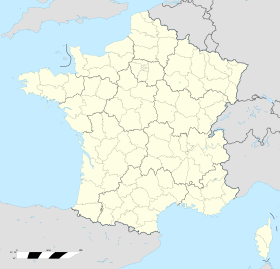Ouvrage La Ferté
| Ouvrage La Ferté | |
|---|---|
| Part of Maginot Line | |
| Northeast France | |

Mixed arms turret, La Ferté
|
|
| Coordinates | 49°35′05″N 5°13′59″E / 49.58482°N 5.23293°E |
| Site information | |
| Owner | Ministry of Defense |
| Controlled by | France |
| Open to the public |
Yes |
| Condition | Preserved as a war memorial |
| Site history | |
| Built by | CORF |
| Materials | Concrete, steel, deep excavation |
| Battles/wars | |
| Official name | Ouvrage de la Ferté |
| Designated | 1980 |
| Reference no. | PA00078437 |
| Denomination | Fortification |
| Ouvrage La Ferté | |
|---|---|
| Type of work: | Small artillery work (Petit ouvrage) |
|
sector └─sub-sector |
Fortified Sector of Montmédy └─Tête du Pont de Montmédy |
| Regiment: | 155th Fortress Infantry Regiment (RIF), 169th Position Artillery Regiment (RAP) |
| Number of blocks: | 2 |
| Strength: | 3 officers, 97 men |
Ouvrage La Ferté, also known as Ouvrage Villy-La Ferté, is a petit ouvrage of the Maginot Line, located in the Fortified Sector of Montmédy, facing Belgium. The ouvrage lies between the towns of Villy and La Ferté-sur-Chiers. It possesses two combat blocks linked by an underground gallery. The westernmost position in its sector, it was a comparatively weakly armed fortification in an exposed position that left it vulnerable to isolation and attack. After a sustained attack during the Battle of France the position was overwhelmed by German forces and was destroyed with its entire garrison killed. The fighting at La Ferté was the heaviest of any position in the Maginot Line. It is preserved as a war memorial.
La Ferté is one of four positions in the so-called Tête du Pont de Montmédy ("Montmédy Bridgehead"), a salient in the French defensive lines along the Belgian border. The isolated area was one of the "New Fronts" to the west of the main Maginot Line, created to defend against the increased threat of a German advance through Belgium. The New Front positions suffered from restricted funding, as well as discontinuity in the fortification lines. Large distances between fortifications compared to earlier portions of the Line made mutual support between ouvrages difficult.
The site was approved in 1934, under the supervision of CORF (Commission d'Organisation des Régions Fortifiées), the Maginot Line's design and construction agency. Work by the contractor Chanel of Antibes began in 1935 at a cost of 14.5 million francs. A second phase was planned to add an artillery block. This was scaled back to a pair of separate artillery casemates. A separate entrance block was proposed in April 1940, linking to the casemates. As the initial confrontation with Germany was already underway, it was too late to be built, with a projected construction time of 18 months.
Compared to earlier Maginot positions, the La Ferté site suffered from a number of design and construction deficiencies. The site contours around Block 2 required a great deal of rubble fill to cover the sides of the block. This rubble had not yet stabilized by the spring of 1940 and could be dislodged by artillery fire. Block 2 suffered from restricted fields of fire to the west and southwest, which were covered only by an automatic rifle cloche. The nearby road ran in a cutting that could not be swept by direct fire. Since La Ferté lacked mortars, the road was dead ground.
...
Wikipedia

